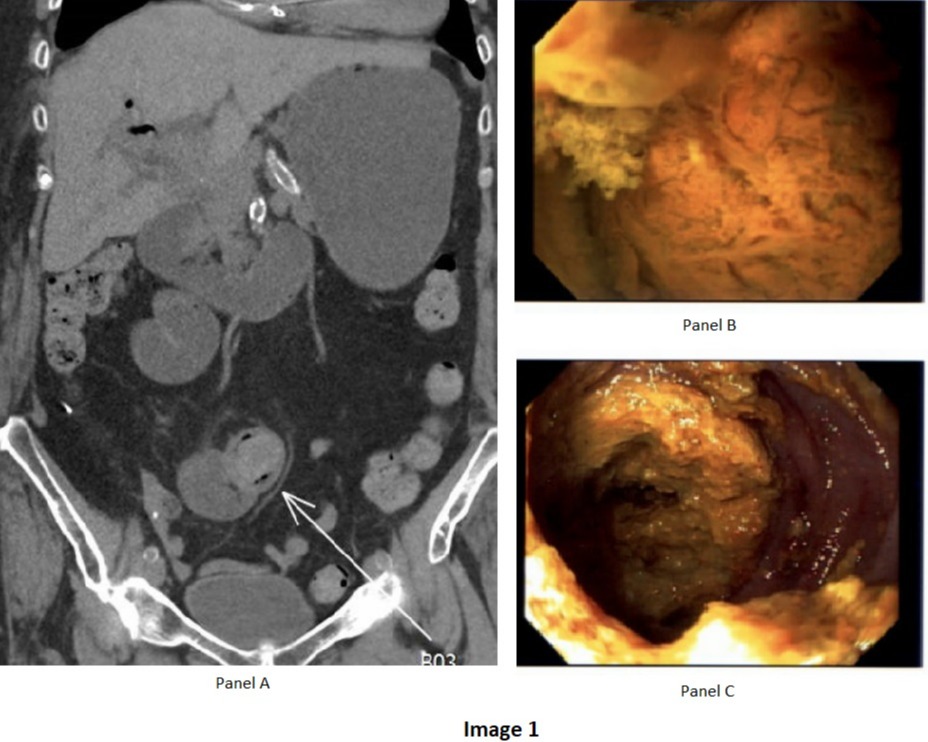Back
Poster Session C - Monday Afternoon
C0586 - Gallstone Ileus: An Unusual Cause of Small Bowel Obstruction After Liver Transplantation
Monday, October 24, 2022
3:00 PM – 5:00 PM ET
Location: Crown Ballroom

Ahmed Elkafrawy, MD
University of Iowa Hospitals and Clinics
Iowa City, IA
Presenting Author(s)
Ahmed Elkafrawy, MD1, Mohamed K. Ahmed, MD2, Antonio Sanchez, MD1
1University of Iowa Hospitals and Clinics, Iowa City, IA; 2University of Missouri Kansas City School of Medicine, Kansas City, MO
Introduction: Liver transplantation is the only curative treatment for patients with decompensated liver disease. The prevalence of biliary complications after a deceased donor liver transplant is estimated between 10 to 15%. Biliary leaks and strictures are the most common biliary complications. We are presenting a rare case of gallstone ileus at the biliary limb in a patient with a complicated post-liver transplant course.
Case Description/Methods: A 78-year-old female with a history of NASH cirrhosis for which she underwent a deceased donor liver transplant ten years before presentation. Post-transplant course was complicated by anastomotic biliary strictures, recurrent choledocholithiasis, and recurrent cholangitis requiring multiple ERCPs with placement of multiple biliary stents. She underwent Roux-en-Y hepaticojejunostomy three years before presentation with marked improvement in the number of cholangitis episodes. She presented with intractable nausea and vomiting. Physical exam showed abdominal distention and periumbilical tenderness but no rebound tenderness or rigidity. Labs were significant for a mild rise in serum creatinine but no leukocytosis and liver chemistries were normal. CT abdomen revealed small bowel obstruction with a transition point at the right lower quadrant anastomosis suspecting phytobezoar at the jejuno-jejunal anastomosis. The patient underwent push enteroscopy to decompress the obstructed limb and remove the suspected food material. The scope was advanced to the jejuno-jejunal anastomosis. About 15 cm beyond the afferent limb, the lumen was entirely occluded by a giant stone measuring (3.5 cm x 2.5 cm). The stone had sequential rings and appeared as a cholesterol stone. The stone was fragmented using grasping forceps, snares, and dilating balloons. It was successfully fragmented into 15-20 smaller stones over three hours duration. The scope was advanced beyond the fragmented stones. A nasogastric tube was inserted for decompression. Patient symptoms resolved following the procedure, and she was discharged home with no recurrence.
Discussion: Biliary leaks and strictures are the most common biliary complications following liver transplant. Gallstone ileus should be considered in liver transplant patients presenting with small bowel obstruction, especially if they have a history of recurrent biliary complications. Prompt recognition of this complication is key, endoscopic lithotripsy should be attempted first in these patients as they are usually high risk surgical candidates.

Disclosures:
Ahmed Elkafrawy, MD1, Mohamed K. Ahmed, MD2, Antonio Sanchez, MD1. C0586 - Gallstone Ileus: An Unusual Cause of Small Bowel Obstruction After Liver Transplantation, ACG 2022 Annual Scientific Meeting Abstracts. Charlotte, NC: American College of Gastroenterology.
1University of Iowa Hospitals and Clinics, Iowa City, IA; 2University of Missouri Kansas City School of Medicine, Kansas City, MO
Introduction: Liver transplantation is the only curative treatment for patients with decompensated liver disease. The prevalence of biliary complications after a deceased donor liver transplant is estimated between 10 to 15%. Biliary leaks and strictures are the most common biliary complications. We are presenting a rare case of gallstone ileus at the biliary limb in a patient with a complicated post-liver transplant course.
Case Description/Methods: A 78-year-old female with a history of NASH cirrhosis for which she underwent a deceased donor liver transplant ten years before presentation. Post-transplant course was complicated by anastomotic biliary strictures, recurrent choledocholithiasis, and recurrent cholangitis requiring multiple ERCPs with placement of multiple biliary stents. She underwent Roux-en-Y hepaticojejunostomy three years before presentation with marked improvement in the number of cholangitis episodes. She presented with intractable nausea and vomiting. Physical exam showed abdominal distention and periumbilical tenderness but no rebound tenderness or rigidity. Labs were significant for a mild rise in serum creatinine but no leukocytosis and liver chemistries were normal. CT abdomen revealed small bowel obstruction with a transition point at the right lower quadrant anastomosis suspecting phytobezoar at the jejuno-jejunal anastomosis. The patient underwent push enteroscopy to decompress the obstructed limb and remove the suspected food material. The scope was advanced to the jejuno-jejunal anastomosis. About 15 cm beyond the afferent limb, the lumen was entirely occluded by a giant stone measuring (3.5 cm x 2.5 cm). The stone had sequential rings and appeared as a cholesterol stone. The stone was fragmented using grasping forceps, snares, and dilating balloons. It was successfully fragmented into 15-20 smaller stones over three hours duration. The scope was advanced beyond the fragmented stones. A nasogastric tube was inserted for decompression. Patient symptoms resolved following the procedure, and she was discharged home with no recurrence.
Discussion: Biliary leaks and strictures are the most common biliary complications following liver transplant. Gallstone ileus should be considered in liver transplant patients presenting with small bowel obstruction, especially if they have a history of recurrent biliary complications. Prompt recognition of this complication is key, endoscopic lithotripsy should be attempted first in these patients as they are usually high risk surgical candidates.

Figure: Panel A: CT abdomen and pelvis showing dense luminal material at the transition point.
Panel B: Endoscopic image of the cholesterol stone occluding the lumen before lithotripsy.
Panel C: Endoscopic image of the cholesterol stone after the lithotripsy.
Panel B: Endoscopic image of the cholesterol stone occluding the lumen before lithotripsy.
Panel C: Endoscopic image of the cholesterol stone after the lithotripsy.
Disclosures:
Ahmed Elkafrawy indicated no relevant financial relationships.
Mohamed Ahmed indicated no relevant financial relationships.
Antonio Sanchez indicated no relevant financial relationships.
Ahmed Elkafrawy, MD1, Mohamed K. Ahmed, MD2, Antonio Sanchez, MD1. C0586 - Gallstone Ileus: An Unusual Cause of Small Bowel Obstruction After Liver Transplantation, ACG 2022 Annual Scientific Meeting Abstracts. Charlotte, NC: American College of Gastroenterology.
